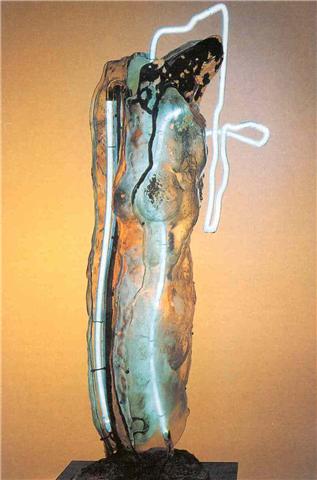
Zdeněk Pešánek. Torsos of Men and Women (1936) [1]
“Artificial Light Art pioneers such as the Czech artist Zdeněk Pešánek illustrate the great attraction that artifical light has held for artists for almost a century. It is impossible for me to look at Pešánek’s work on display without thinking of his contemporary Siegfried Kracauer who conceived of electricity and light as pure flows – part of a modernity’s machinic libidinality. Long before Dan Flavin discovered the fluorescent tube Pešánek was using neon and other artifical media to make Light Art. He projected light using what he called a spectrophone
and was asked by the organizers of the 1937 Paris World Fair to make two fountains of light using neon tubing. He was also hired by the Prague electric utility to make light sculptures. Among these were his abstract Torsos of Men and Women a work in which the illusion of movement is created by the electric circuitry alternating power to the light tubes. It is an unusual type of kinetic light work for its time that soon descended into the predictable in the hands of advertisers. Paris would endure the kinetic banality of the “Citröen” logo on the Eiffel Tower for many years. Pešánek also made the kinetic light sculpture which adorned the roof of Edison Power Station in Prague.” [1]

Zdeněk Pešánek. Kinetic Sculpture for Prague’s Edison Power Station [1]
“Pešánek shows us an entirely new way to understand the formal qualities of Russian Constructivism in the shapes which merge to make the Edison sculpture. From its origins Light Art showed that it could be both interesting and artful by using artifical light and technology.
Technology is however a double-edged sword for Light Art. While it can be used to deploy artifical light in artistic ways, it is also possible that the technology overwhelms the artwork producing neither illusion nor interest. Pešánek set Light Art on a higher course than it would always find itself. Before examining these failures it is important to look at some of the other successful (artful) uses of artifical light for making art.” [1]
[1]: http://www.euroartmagazine.com/new/?page=1&content=198
